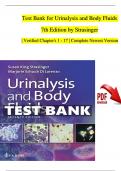Exam (elaborations)
TEST BANK For Urinalysis and Body Fluids, 7th Edition by Strasinger | Verified Chapters 1 - 17 | Complete Newest Version
TEST BANK For Urinalysis and Body Fluids, 7th Edition by Strasinger | Verified Chapters 1 - 17 | Complete Newest Version TEST BANK For Urinalysis and Body Fluids, 7th Edition by Strasinger | Verified Chapters 1 - 17 | Complete Newest Version TEST BANK For Urinalysis and Body Fluids, 7th Edition by...
[Show more]



